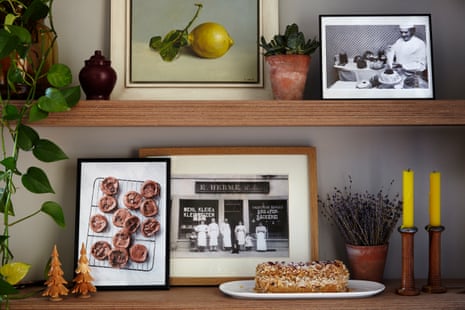Coming from a family of baker-patissiers, I grew up with the smell of baking bread. We lived in a working-class part of Colmar in Alsace, where there were lots of textile factories and market gardens.
Our house was above my parents’ bakery and workshop, at number 11 avenue d’Alsace. It was a long building from the 1940s or 1950s, with everything arranged in a row: the bakery, the oven, the table for shaping the bread, the kneading machine, the washing-up area and, at the back, the pastry station with big machines for mixing and grinding. It felt a lot like a lab.
In front of the building was a courtyard where I spent most of my time playing. I was an only child, and my parents worked all the time, my father in his workshop, my mother in the shop. I’d have liked to have had someone to play with. But I also liked working. The only way I could spend time with my father was to go to the workshop – that is probably why I knew I wanted to be a patissier from the age of nine.
I came to Paris when I was 14, and worked as an apprentice under the caterer and patissier Gaston Lenôtre. I remember one day tasting his chestnut and pear ice-cream and thinking that I had absolutely no idea chestnuts or pears could taste like that.
I loved my father’s baba au rhum, which he made for special occasions, with whipped cream and fruit. It wasn’t really a kids’ dish, but I was always allowed to have some. The spongy texture of the cake, with the cream … what a dream. It was – is – heaven. I also loved his tartes aux quetsches – damson tarts. The smell of those baking was my favourite.
The Christmas period, in particular, meant lots of work – I didn’t enjoy this time of year much. But I did help my parents. They’d give me simple things to do, like decorating the bûches de Noël with little plastic elves or Christmas trees. And I’d help my grandfather make deliveries to clients. We always had an enormous tree in the bakery, which I loved to decorate with garlands and baubles. I still love the way the glass balls reflect the lights. And my father made all the traditional Alsatian Christmas biscuits – bredeles – some of which were sablés, like the recipe below, only much simpler.
In my workshop, in terms of the creation and development of ideas, the Christmas period starts on 2 January and lasts until May. We don’t make anything traditional other than stollen, which I love, but come December, we do always have a big tree.
Sablé infiniment chocolat
The quality of the chocolate is most important for the flavour of these biscuits, and the fleur de sel serves to highlight it. The secret to the texture is to make sure the dough is cold before going in the oven, and not to overbake. The centre should be soft. Ideally you want to leave the biscuits for an hour, then coat them in melted chocolate before eating. Push the chocolate flavour to the limit.
Makes 40-60
150g 70% cocoa baking chocolate such as Valrhona Guanaja
175g flour
30g cocoa
1 tsp bicarbonate of soda
150g butter, at room temperature
120g light brown sugar
50g caster sugar
¾ tsp fleur de sel
¼ tsp vanilla extract
1 Chop the chocolate with a serrated knife. Sift the flour, cocoa and bicarbonate of soda together.
2 Put the butter in a bowl and soften with a spatula. Add the chocolate, sugars, fleur de sel and vanilla and mix well, then incorporate the flour-cocoa-bicarb mixture. Mix rapidly until combined, without overworking.
3 Divide the dough into three equal parts and roll each piece into a 15- to 20cm-long sausage.
4 Wrap each piece in clingfilm and refrigerate for 2 hours. Heat the oven to 170C/335F/gas mark 3½.
5 Remove the plastic film from the dough and slice into 1cm-thick discs. Place the discs on a baking tray lined with cooking parchment and bake for 11-12 minutes. Remember: it’s important that you don’t overcook them.
- Pierre Hermé is a Paris-based chocolatier and winner of the best pastry chef 2016 in the World’s 50 Best Restaurants awards. His new recipe book, Chocolate, is published by Flammarion; pierreherme.com

Comments (…)
Sign in or create your Guardian account to join the discussion